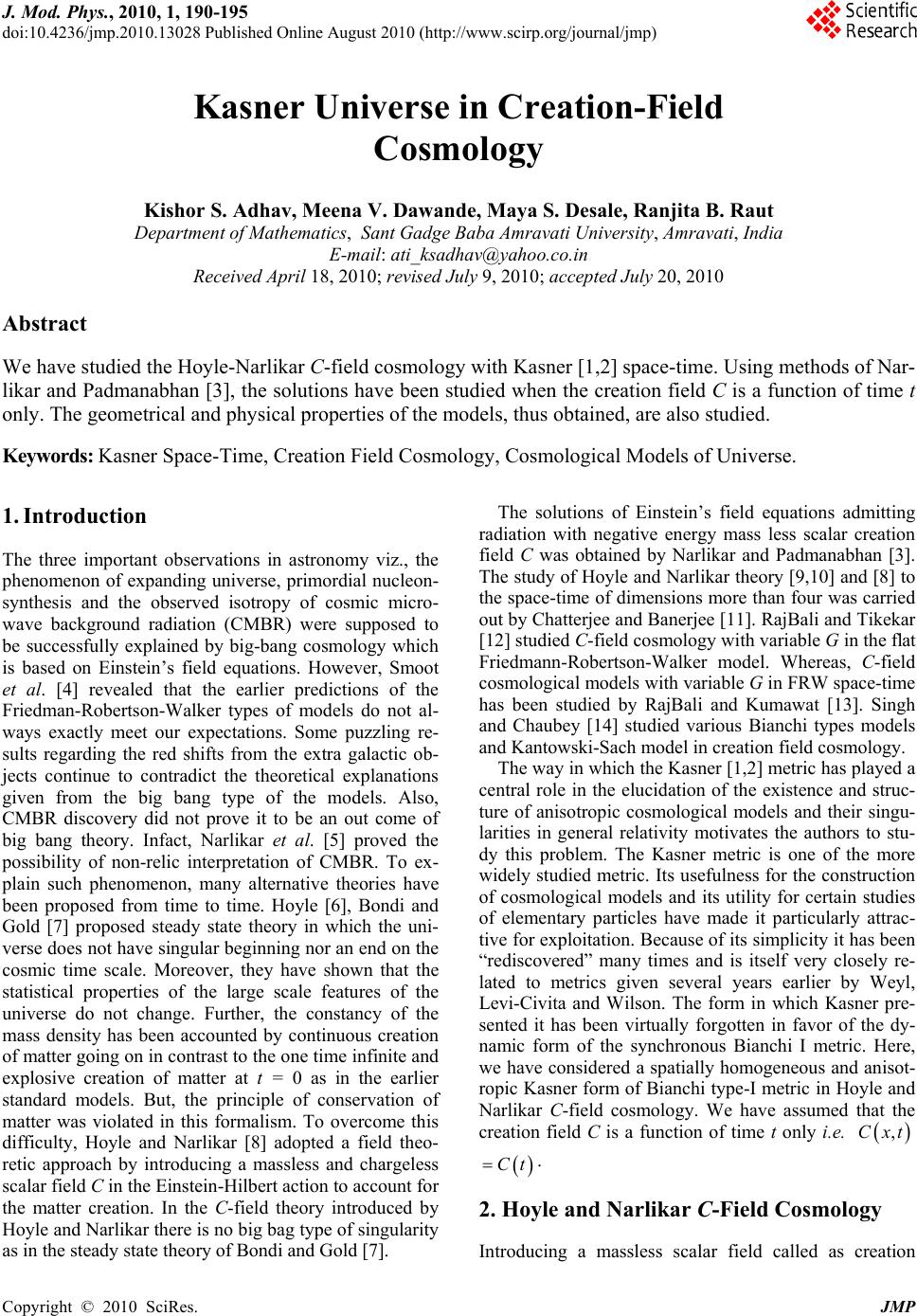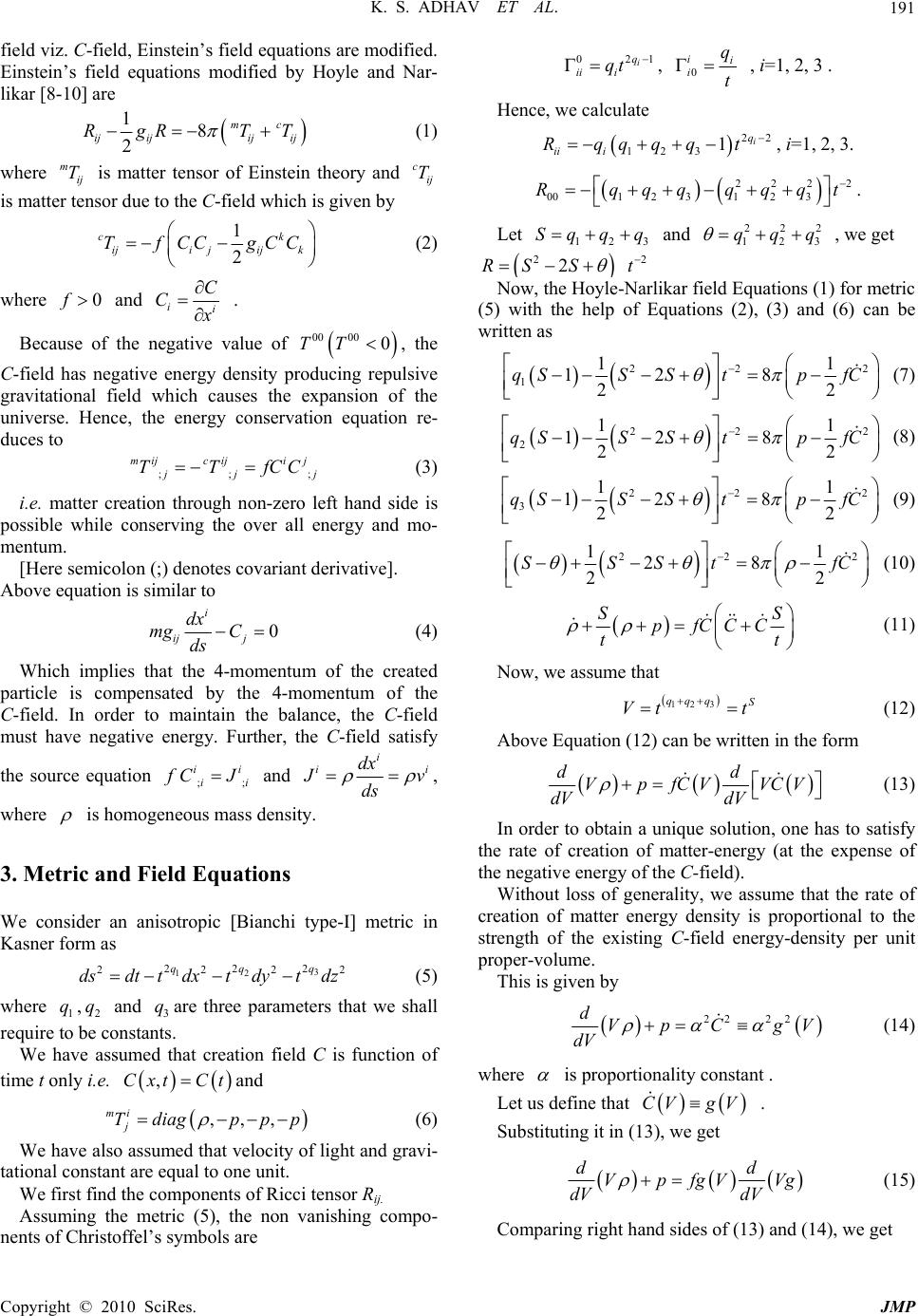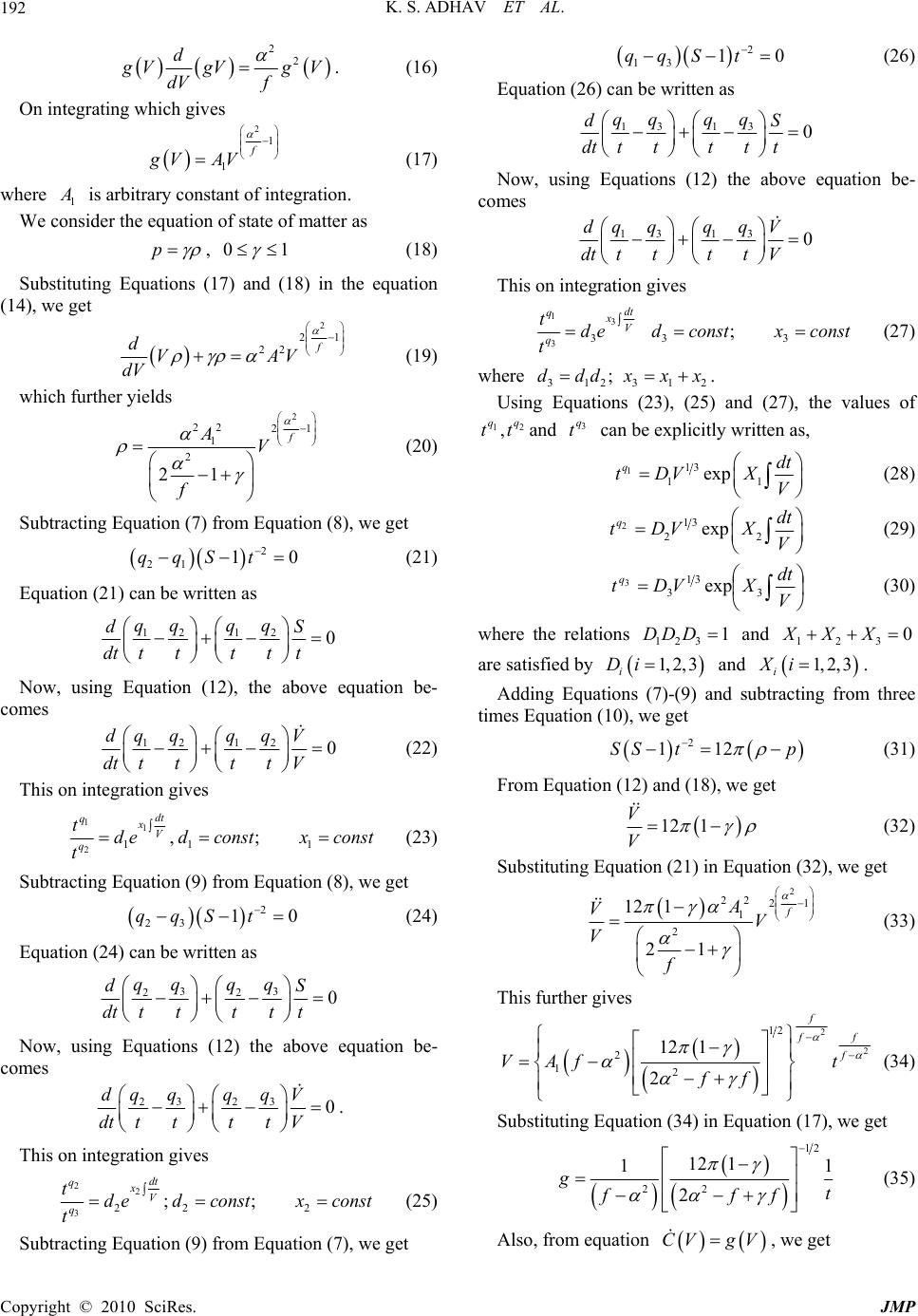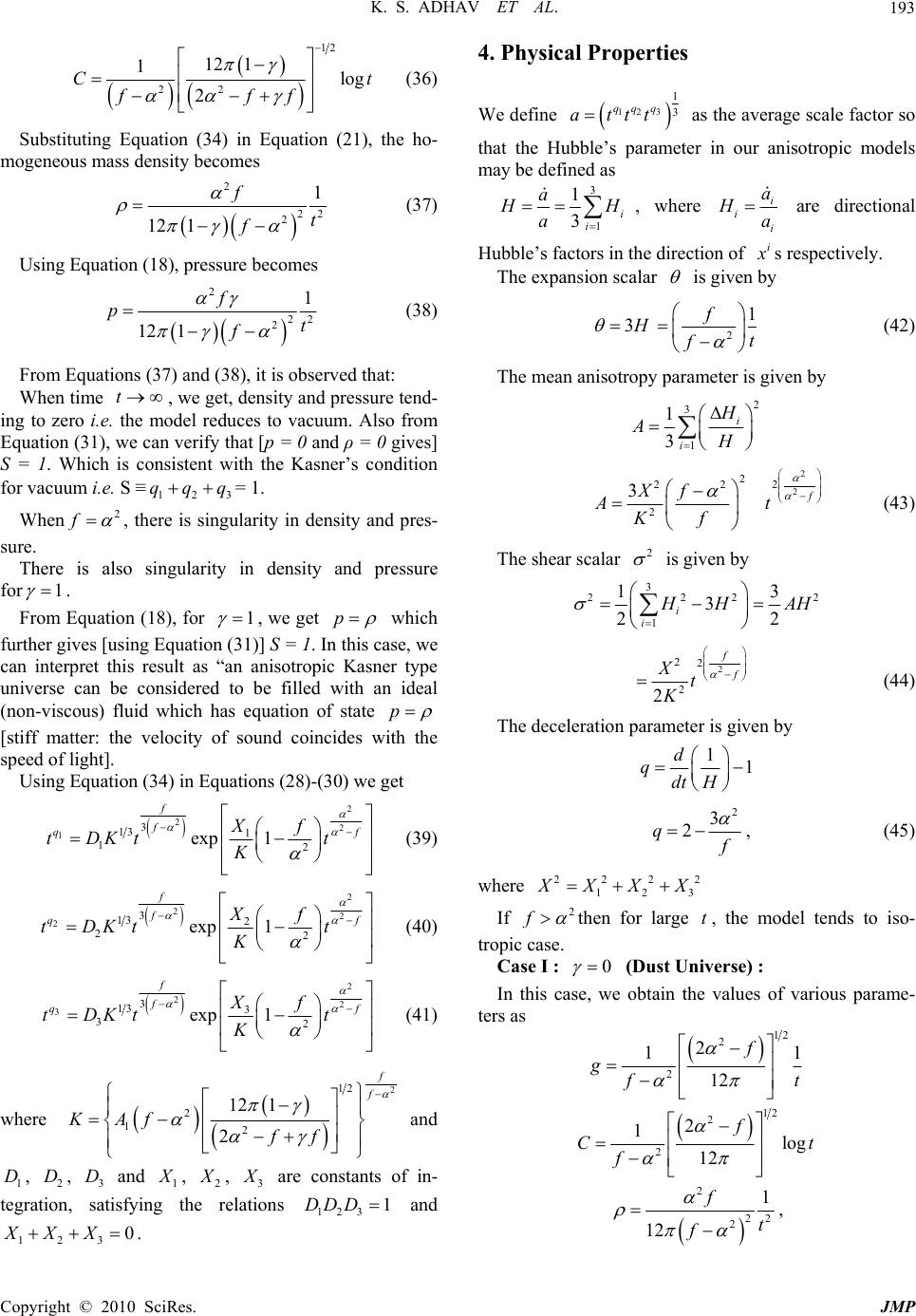Paper Menu >>
Journal Menu >>
 J. Mod. Phys., 2010, 1, 190-195 doi:10.4236/jmp.2010.13028 Published Online August 2010 (http://www.scirp.org/journal/jmp) Copyright © 2010 SciRes. JMP Kasner Universe in Creation-Field Cosmology Kishor S. Adhav, Meena V. Dawande, Maya S. Desale, Ranjita B. Raut Department of Mathematics, Sant Gadge Baba Amravati University, Amravati, India E-mail: ati_ksadhav@yahoo.co.in Received April 18, 2010; revised July 9, 2010; accepted July 20, 2010 Abstract We have studied the Hoyle-Narlikar C-field cosmology with Kasner [1,2] space-time. Using methods of Nar- likar and Padmanabhan [3], the solutions have been studied when the creation field C is a function of time t only. The geometrical and physical properties of the models, thus obtained, are also studied. Keywords: Kasner Space-Time, Creation Field Cosmology, Cosmological Models of Universe. 1. Introduction The three important observations in astronomy viz., the phenomenon of expanding universe, primordial nucleon- synthesis and the observed isotropy of cosmic micro- wave background radiation (CMBR) were supposed to be successfully explained by big-bang cosmology which is based on Einstein’s field equations. However, Smoot et al. [4] revealed that the earlier predictions of the Friedman-Robertson-Walker types of models do not al- ways exactly meet our expectations. Some puzzling re- sults regarding the red shifts from the extra galactic ob- jects continue to contradict the theoretical explanations given from the big bang type of the models. Also, CMBR discovery did not prove it to be an out come of big bang theory. Infact, Narlikar et al. [5] proved the possibility of non-relic interpretation of CMBR. To ex- plain such phenomenon, many alternative theories have been proposed from time to time. Hoyle [6], Bondi and Gold [7] proposed steady state theory in which the uni- verse does not have singular beginning nor an end on the cosmic time scale. Moreover, they have shown that the statistical properties of the large scale features of the universe do not change. Further, the constancy of the mass density has been accounted by continuous creation of matter going on in contrast to the one time infinite and explosive creation of matter at t = 0 as in the earlier standard models. But, the principle of conservation of matter was violated in this formalism. To overcome this difficulty, Hoyle and Narlikar [8] adopted a field theo- retic approach by introducing a massless and chargeless scalar field C in the Einstein-Hilbert action to account for the matter creation. In the C-field theory introduced by Hoyle and Narlikar there is no big bag type of singularity as in the steady state theory of Bondi and Gold [7]. The solutions of Einstein’s field equations admitting radiation with negative energy mass less scalar creation field C was obtained by Narlikar and Padmanabhan [3]. The study of Hoyle and Narlikar theory [9,10] and [8] to the space-time of dimensions more than four was carried out by Chatterjee and Banerjee [11]. RajBali and Tikekar [12] studied C-field cosmology with variable G in the flat Friedmann-Robertson-Walker model. Whereas, C-field cosmological models with variable G in FRW space-time has been studied by RajBali and Kumawat [13]. Singh and Chaubey [14] studied various Bianchi types models and Kantowski-Sach model in creation field cosmology. The way in which the Kasner [1,2] metric has played a central role in the elucidation of the existence and struc- ture of anisotropic cosmological models and their singu- larities in general relativity motivates the authors to stu- dy this problem. The Kasner metric is one of the more widely studied metric. Its usefulness for the construction of cosmological models and its utility for certain studies of elementary particles have made it particularly attrac- tive for exploitation. Because of its simplicity it has been “rediscovered” many times and is itself very closely re- lated to metrics given several years earlier by Weyl, Levi-Civita and Wilson. The form in which Kasner pre- sented it has been virtually forgotten in favor of the dy- namic form of the synchronous Bianchi I metric. Here, we have considered a spatially homogeneous and anisot- ropic Kasner form of Bianchi type-I metric in Hoyle and Narlikar C-field cosmology. We have assumed that the creation field C is a function of time t only i.e. ,Cxt Ct . 2. Hoyle and Narlikar C-Field Cosmology Introducing a massless scalar field called as creation  K. S. ADHAV ET AL. Copyright © 2010 SciRes. JMP 191 field viz. C-field, Einstein’s field equations are modified. Einstein’s field equations modified by Hoyle and Nar- likar [8-10] are 18 2 mc ijijij ij RgR TT (1) where m ij T is matter tensor of Einstein theory and c ij T is matter tensor due to the C-field which is given by 1 2 ck iji jijk TfCCgCC (2) where 0f and ii C C x . Because of the negative value of 0000 0TT , the C-field has negative energy density producing repulsive gravitational field which causes the expansion of the universe. Hence, the energy conservation equation re- duces to ;; ; mijciji j j jj TTfCC (3) i.e. matter creation through non-zero left hand side is possible while conserving the over all energy and mo- mentum. [Here semicolon (;) denotes covariant derivative]. Above equation is similar to 0 i ij j dx mg C ds (4) Which implies that the 4-momentum of the created particle is compensated by the 4-momentum of the C-field. In order to maintain the balance, the C-field must have negative energy. Further, the C-field satisfy the source equation ;; ii ii f CJ and i ii dx J v ds , where is homogeneous mass density. 3. Metric and Field Equations We consider an anisotropic [Bianchi type-I] metric in Kasner form as 3 12 2 22 2222 q qq dsdt tdxtdytdz (5) where 1 q,2 q and 3 qare three parameters that we shall require to be constants. We have assumed that creation field C is function of time t only i.e. ,Cxt Ctand ,,, mi j Tdiag ppp (6) We have also assumed that velocity of light and gravi- tational constant are equal to one unit. We first find the components of Ricci tensor Rij. Assuming the metric (5), the non vanishing compo- nents of Christoffel’s symbols are 21 0i q ii i qt , 0 ii i q t , i=1, 2, 3 . Hence, we calculate 22 123 1i q ii i Rqqqqt , i=1, 2, 3. 222 2 001 23123 Rqqqqqqt . Let 123 Sqq q and 222 123 qqq , we get 22 2RS St Now, the Hoyle-Narlikar field Equations (1) for metric (5) with the help of Equations (2), (3) and (6) can be written as 22 2 1 11 12 8 22 qSSStpfC (7) 22 2 2 11 12 8 22 qSSStp fC (8) 22 2 3 11 12 8 22 qSSStp fC (9) 22 2 11 28 22 SSStfC (10) SS pfCCC tt (11) Now, we assume that 123 qq qS Vt t (12) Above Equation (12) can be written in the form dd VpfCV VCV dV dV (13) In order to obtain a unique solution, one has to satisfy the rate of creation of matter-energy (at the expense of the negative energy of the C-field). Without loss of generality, we assume that the rate of creation of matter energy density is proportional to the strength of the existing C-field energy-density per unit proper-volume. This is given by 22 22 dVpC gV dV (14) where is proportionality constant . Let us define that CV gV . Substituting it in (13), we get dd VpfgV Vg dV dV (15) Comparing right hand sides of (13) and (14), we get  K. S. ADHAV ET AL. Copyright © 2010 SciRes. JMP 192 2 2 d g VgVgV dV f . (16) On integrating which gives 2 1 1 f gV AV (17) where 1 A is arbitrary constant of integration. We consider the equation of state of matter as p , 01 (18) Substituting Equations (17) and (18) in the equation (14), we get 2 21 22 f dVAV dV (19) which further yields 2 22 21 1 2 21 f AV f (20) Subtracting Equation (7) from Equation (8), we get 2 21 10qqS t (21) Equation (21) can be written as 12 12 0 qq qq dS dttt ttt Now, using Equation (12), the above equation be- comes 12 120 qq qq dV dt ttttV (22) This on integration gives 11 21 dt qxV q tde t ,11 ;dconstx const (23) Subtracting Equation (9) from Equation (8), we get 2 23 10qqS t (24) Equation (24) can be written as 33 220 qq qq dS dt ttttt Now, using Equations (12) the above equation be- comes 33 220 qq qq dV dttttt V . This on integration gives 22 32 dt qxV q tde t ;22 ;dconstx const (25) Subtracting Equation (9) from Equation (7), we get 2 13 10qqS t (26) Equation (26) can be written as 33 110 qq qq dS dtttttt Now, using Equations (12) the above equation be- comes 33 110 qq qq dV dtttttV This on integration gives 13 33 dt qxV q tde t 33 ;dconstx const (27) where 312312 ;dddxxx . Using Equations (23), (25) and (27), the values of 12 , qq ttand 3 q t can be explicitly written as, 113 11 exp qdt tDV X V (28) 213 22 exp qdt tDV X V (29) V dt XVDtq 3 31 3exp 3 (30) where the relations 123 1DDD and 123 0XX X are satisfied by 1, 2, 3 i Di and 1, 2, 3 i Xi. Adding Equations (7)-(9) and subtracting from three times Equation (10), we get 2 112SS tp (31) From Equation (12) and (18), we get 12 1 V V (32) Substituting Equation (21) in Equation (32), we get 2 22 21 1 2 12 1 21 f A VV V f (33) This further gives 2 2 12 2 12 12 1 2 f f f f VAf t ff (34) Substituting Equation (34) in Equation (17), we get 12 22 12 1 11 2 gt fff (35) Also, from equation CV gV , we get  K. S. ADHAV ET AL. Copyright © 2010 SciRes. JMP 193 12 22 12 1 1log 2 Ct fff (36) Substituting Equation (34) in Equation (21), the ho- mogeneous mass density becomes 2 22 2 1 12 1 f t f (37) Using Equation (18), pressure becomes 2 22 2 1 12 1 f pt f (38) From Equations (37) and (38), it is observed that: When time t, we get, density and pressure tend- ing to zero i.e. the model reduces to vacuum. Also from Equation (31), we can verify that [p = 0 and ρ = 0 gives] S = 1. Which is consistent with the Kasner’s condition for vacuum i.e. S ≡123 qqq= 1. When 2 f , there is singularity in density and pres- sure. There is also singularity in density and pressure for 1 . From Equation (18), for 1 , we get p which further gives [using Equation (31)] S = 1. In this case, we can interpret this result as “an anisotropic Kasner type universe can be considered to be filled with an ideal (non-viscous) fluid which has equation of state p [stiff matter: the velocity of sound coincides with the speed of light]. Using Equation (34) in Equations (28)-(30) we get 2 22 13 13 1 12 exp 1 f f q f Xf tDKt t K (39) 2 22 23 13 2 22 exp 1 f f q f Xf tDKt t K (40) 2 22 33 13 3 32 exp 1 f f q f Xf tDKt t K (41) where 2 12 2 12 12 1 2 f f KAf ff and 1 D, 2 D, 3 D and 1 X , 2 X , 3 X are constants of in- tegration, satisfying the relations 123 1DDD and 123 0XX X. 4. Physical Properties We define 3 12 1 3 q qq attt as the average scale factor so that the Hubble’s parameter in our anisotropic models may be defined as 3 1 1 3i i a H H a , where i i i a Ha are directional Hubble’s factors in the direction of i x s respectively. The expansion scalar is given by 3 H 2 1f t f (42) The mean anisotropy parameter is given by 2 3 1 1 3 i i H AH 2 2 2 22 2 2 3 f Xf At f K (43) The shear scalar 2 is given by 3 2222 1 13 3 22 i i H HAH 2 22 2 2 f f Xt K (44) The deceleration parameter is given by 11 d qdtH 2 3 2q f , (45) where 2222 12 3 X XXX If 2 f then for large t, the model tends to iso- tropic case. Case I : 0 (Dust Universe) : In this case, we obtain the values of various parame- ters as 12 2 2 2 11 12 f gt f 12 2 2 2 1log 12 f Ct f 2 22 2 1 12 f t f ,  K. S. ADHAV ET AL. Copyright © 2010 SciRes. JMP 194 2 22 13 13 1 11 2 1 exp 1 f f q f Xf tDKt t K 2 22 23 13 2 21 2 1 exp 1 f f q f Xf tDKt t K 2 22 33 13 3 31 2 1 exp 1 f f q f Xf tDKt t K where 2 12 2 12 12 2 f f KAf f Here 1 D, 2 D, 3 D and 1 X , 2 X , 3 X are con- stants of integration, satisfying the relations 123 1DDD and 123 0XX X . In this case, the expansion scalar is given by 2 1f t f , The mean anisotropy parameter is given by 2 2 2 22 2 2 1 3 f Xf At f K The shear scalar 2 is given by 2 22 2 2 1 2 f f Xt K The deceleration parameter is given by 2 3 2q f , where 2222 12 3 X XXX If 2 f , this model also tends to isotropy for large t . Case II : 1 3 (Disordered Radiation Universe) In this case, we obtain the values of various parame- ters as 12 2 2 3 11 12 f gt f 12 2 2 3 1log 12 f Ct f 2 22 2 31 24 f t f , 2 22 2 1 24 f pt f 2 22 13 13 1 12 2 2 exp 1 f f q f Xf tDKt t K 2 22 23 13 2 22 2 2 exp 1 f f q f Xf tDKt t K 2 22 33 13 3 32 2 2 exp 1 f f q f Xf tDKt t K where 2 12 2 21 2 12 f f KAff . Here 1 D,2 D,3 D and 1 X ,2 X ,3 X are constants of integration, satisfying the relations 1231DDD and 123 0XXX . In this case, the expansion scalar is given by 2 1f t f . The mean anisotropy parameter is given by 2 2 2 22 2 2 2 3 f Xf At f K The shear scalar 2 is given by 2 22 2 2 2 2 f f Xt K The deceleration parameter is given by 2 3 2qf where 2222 12 3 X XXX or2 f , this model also tends to isotropy for large t . 5. Discussion 1) In both cases for2 f , we get negative decelera- tion parameter indicating that the universe is accelerating. This observation is consistent with the present day ob- servation. 2) The expansion scalar starts with an infinite value at t = 0, further gradually decreases & the expan- sion halts when t = ∞. 3) For2 f , we get lim 0 t . Therefore, the mod- els are isotropic for large value of t. 4) Also, we have noticed that matter density is in- versely proportional to square of time t. When t →0, we  K. S. ADHAV ET AL. Copyright © 2010 SciRes. JMP 195 get ρ→∞ and when t →∞, we get ρ→0. These are all physically valid results indicating that there is a situation where Kasner type C-field cosmology starts from infinite mass density. 5) In general, we have observed that the creation field C is proportional to time t. That is, the creation of matter increases as time increases. 6. References [1] E. Kasner, “Geometrical Theorem on Einstein’s Cosmo- logical Equations,” American Journal of Mathematics, Vol. 43, No. 2, 1921, pp. 217-221. [2] E. Kasner, “An Algebraic Solution of the Einstein Equa- tions,” Transactions of the American Mathematical Soci- ety, Vol. 27, No. 1, 1925, pp. 101-105. [3] J. V. Narlikar and T. Padmanabhan, “Creation-Field Co- smology: A Possible Solution to Singularity, Horizon, and Flatness Problems,” Physical Review D, Vol. 32, No. 8, 1985, pp. 1928-1934. [4] G. F. Smoot, et al., “Structure in the COBE Differential Microwave Radiometer First-Year Maps,” Astrophysical Journal, Vol. 396, No. 1, 1992, pp. 21-25. [5] J. V. Narlikar, et al., “Inhomogeneities in the Microwave Background Radiation Interpreted within the Framework of the Quasi-Steady State Cosmology,” Astrphysical Journal, Vol. 585, No. 3, 2003, pp. 1-11. [6] F. Hoyle, “A New Model for the Expanding Universe,” Monthly Notices of the Royal Astronomical Society, Vol. 108, No. 1748, 1948, pp. 372-382. [7] H. Bondi and T. Gold, “The Steady-State Theory of the Expanding Universe,” Monthly Notices of the Royal Astr- onomical Society, Vol. 108, No. 3, 1948, pp. 252-270. [8] F. Hoyle and J. V. Narlikar, “A Radical Departure from the ‘Steady-State’ Concept in Cosmology,” Proeedings of Royal Society (London) A, Vol. 290, No. 1421, 1966, pp. 162-176. [9] F. Hoyle and J. V. Narlikar, “Mach’s Principle and the Creation of Matter,” Proceedings of Royal Society (Lon- don) A, Vol. 273, No. 1352, 1963, pp. 1-11. [10] F. Hoyle and J. V. Narlikar “The C-Field as a Direct Par- ticle Field,” Proceedings of Royal Society (London) A, Vol. 282, No. 1389, 1964, pp. 178-183. [11] S. Chatterjee and A. Banerjee, “C-Field Cosmology in Higher Dimensions,” General Relativity Gravitation, Vol. 36, No. 2, 2004, pp. 303-313. [12] R. Bali and R. S. Tikekar, “C-Field Cosmology with Variable G in the Flat Friedmann-Robertson-Walker Model,” Chinese Physics Letters, Vol. 24, No. 11, 2007, pp. 3290-3292. [13] R. Bali and M. Kumawat, “C-Field Cosmological Models with Variable G In FRW Space-Time,” International Journal of Theoretical Physics, Vol. 48, No. 3, 2009,pp. 3410-3415 [14] T. Singh and R. Chaubey, “Bianchi type-I, III, V, VI and Kantowski-Sachs Universes in Creation-Field Cosmol- ogy,” Astrophysical Space Scence, Vol. 321, No. 1, 2009, pp. 5-18. |

